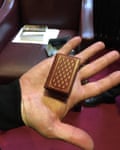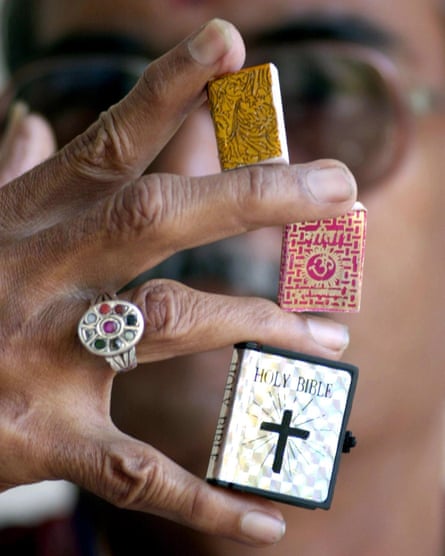It is known as the “fly’s eye Dante”: an 1878 edition of the Divine Comedy which is so small – just 11/4 by 13/4 inches – that it is said to have taken 11 years to print, and to have damaged the eyes of both its compositor and corrector. Bound in red leather embossed with gold, the world’s smallest edition of Dante’s classic poem, which was printed by the Salmin Brothers in Padua, is one of almost 50 officially designated miniature books housed in the London Library. Nomenclature is important here: according to the US-based Miniature Book Society, a miniature book “is no more than three inches in height, width, or thickness”, and while the London Library has some 350-odd “small” books, of less than five inches, it has only 47 true miniatures. The library decided they were being overshadowed by their larger cousins, so now they are gathered together in a glass-fronted cabinet.

Alongside the Dante, there is the smallest AuthorisedVersion of the Bible, first printed by David Bryce of Glasgow in 1896. Bryce said that when he “descended to the miniature, mite and midget size” he had “many a scoff and jeer as to the absurdity of the production”. This edition of the Bible, just an inch across, comes with a tiny magnifying glass tucked into a pocked in its cover (unlike the Dante, which is small but perfectly legible, this book would be impossible to read without one). There is also a miniature edition of Kate Greenaway’s Alphabet from the 1880s, and Dunia Garcia-Ontiveros, who looks after the London Library’s collection, points to the 1828 edition of Horace’s odes, the second book to be published using Henri Didot’s microscopic type. In a display of virtuosity, the text also contains a number of ornamental lines, the centre of which is formed by the letters “Henri Didot” printed even smaller than the type of the main text. I peer over the pages attempting to spot these; at last, using the zoom function on my phone, I find them.
“In its quality, it’s unparallelled,” says Garcia-Ontiveros. “He’s showing off. It was published in the 1820s, that’s quite early. I’m not surprised people called it a miracle.”
The earliest miniature books in the collection date to the 16th century. Books were often made small, according to Garcia-Ontiveros, because they were religious texts – so people wanted to keep them close as they felt emotionally connected to them – or because they were controversial and had “to be secreted about one’s person”, such as Charles Knowlton’s 1832 guide to birth control, The Fruits of Philosophy.

But miniature books have a much longer history. The British Library points to two small cuneiform tablets from ancient Mesopotamia. Both concerned with trading information about animals and provisions, one is dated to around 2325BC and measures 15/8 by 11/2 inches; the other is dated 2200BC and measures 17/8 by 11/4 inches. In AD770, the Japanese empress Shotoku gave orders for the printing of 1m copies of a prayer scroll a mere 23/8 inches tall, the D’harani prayer. These writings were made miniature, writes the British Library’s Annalisa Ricciardi, “so that men and women of faith could easily bring with them their collection of psalms and devotional books, students could carry their small library in a pocket, smugglers of ideas could easily hide tiny booklets in a secret bottom of their cape, merchants could quickly retrieve from their belt a tiny but complete guide on the equivalence of grains prices, scales, measures and conversion, and foreign currencies value meanwhile closing a deal, or sharp businessmen could brilliantly define a legal contract”.
Technological developments in the 1800s made it possible to print text even more. “That’s when you get the truly mind-bogglingly tiny books,” says Garcia-Ontiveros, citing everything from the Horace to Bryce’s Bible to a complete set of Shakespeare’s plays that can be held cupped in two hands.
Simon Garfield, who recently published In Miniature: How Small Things Illuminate the World, says his favourite is the Sherlock Holmes story How Watson Learned the Trick, which was written in the 1920s by Arthur Conan Doyle. “It’s bound in red leather, measures under 4cm by 3cm and contains 503 words. That’s about one page of a regular book, but it’s handwritten and extends to 34 pages,” says Garfield. (The original can be found in Queen Mary’s Dolls’ House in Windsor Castle.) “The title’s ironic: the story, composed almost entirely of dialogue, begins with Watson thinking he’s mastered the art of elementary detection, only to be deflated by Holmes proving him wrong on every count.”

Around the world, collectors coo over the Salmin Brothers’ 1896 copy of Galileo’s 1636 letter to his friend Cristina di Lorena, which Louis Bondy writes in his history of miniature books “was considered the smallest printed from movable type” for many years: it is half the size of a postage stamp. A copy is in MIT Libraries, in Massachusetts, alongside a handful of other miniatures: four addresses by Abraham Lincoln and extracts from Calvin Coolidge’s autobiography. Both are as small as the Galileo, but neither were set from movable type. The National Library of Scotland has one of Bryce’s most famous publications, a miniature Koran printed in Arabic around 1900, copies of which, it says, were often given to Muslim soldiers fighting with allied forces during the first world war, the metal locket allowing it “to be easily worn around the neck of the soldier”.
“The 19th century was absolutely the golden age, the heyday of miniature printing,” says Garcia-Ontiveros. “They were saying, we want to push this to the limit and see how far we can go.”
Those limits have gone from inches to millimetres to micrometres. In 1952, a Munich publisher produced a five-by-five millimetre book containing the Lord’s Prayer in Dutch, English, French, German, Spanish and Swedish (it sold for £1,300 in London in 2006). Guinness World Records lists the smallest reproduction of a printed book as Teeny Ted from Turnip Town, which measures 70 micrometres by 100 micrometres and was etched using an ion beam. Russian scientist Vladimir Aniskin believes he has beaten this with Levsha, his 70-by-90 micrometres book. The pages are turned using a sharpened metal needle.
What is it that makes the world of the miniature so appealing? “It’s the feeling that you can hold the entire works of Shakespeare in your hands,” says Garcia-Ontiveros. “Miniature books were never seen as serious books, they were curiosities, seen as fun objects, not the kind of books that would make it into libraries. They were the books people would have at home, and because they are tiny and often printed on cheap paper they don’t tend to survive, so in any age miniature books are very rare. And they get lost! We ourselves had one fall behind a cabinet and it wasn’t until we had some building work done that one of the builders saw it behind a cabinet. We’d been looking for it for years.”
For Garfield, it is less about content and more about the skill that went into making them at all. “Their size ensures that the reader takes great care in handling and appreciating them. This is the trick of so many miniature objects,” he says. “The smaller they are, the more one looks.”
